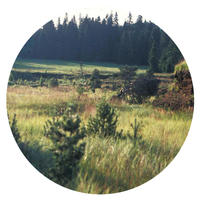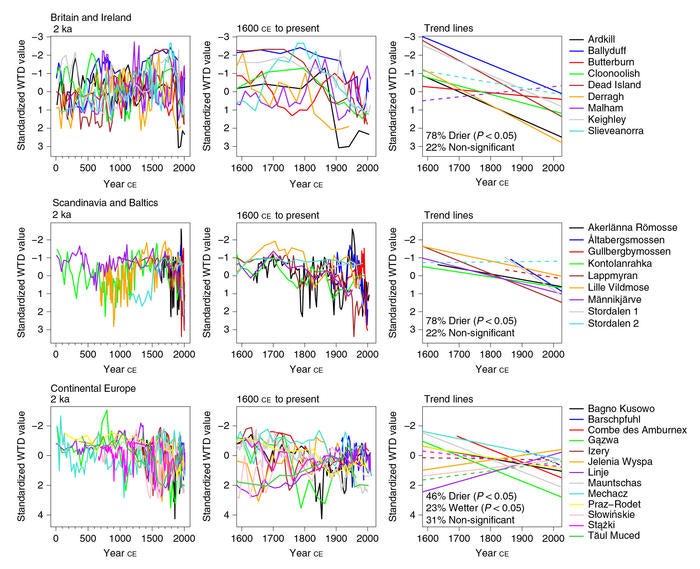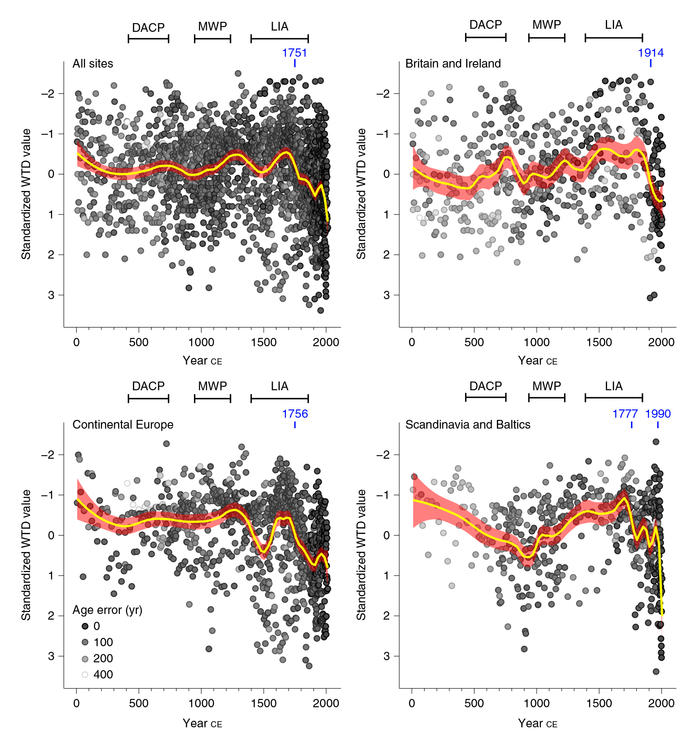 Peatlands act as globally important carbon sinks, containing about 20 per cent of the world’s soil carbon, despite only covering about three per cent of the global landmass. Climate warming and human impacts are thought to be causing peatlands to dry, potentially converting them from sinks to sources of carbon. It is unclear, however, whether the hydrological status of peatlands has moved beyond their natural baseline conditions.
Peatlands act as globally important carbon sinks, containing about 20 per cent of the world’s soil carbon, despite only covering about three per cent of the global landmass. Climate warming and human impacts are thought to be causing peatlands to dry, potentially converting them from sinks to sources of carbon. It is unclear, however, whether the hydrological status of peatlands has moved beyond their natural baseline conditions.
In Europe, peatlands store approximately five times more carbon than forests and about half of Europe’s total soil organic carbon. The maintenance of a shallow water table and near-saturated surface conditions are important for inhibiting carbon losses in these peatlands. The deepening of peatland water tables leads to increasing peat oxidation, in turn causing the peat carbon stock to be decomposed and released to the atmosphere as carbon dioxide. These huge carbon stores therefore deserve an important place in Europe’s climate change policies and management practices.
Although monitoring of peatland water tables is now relatively commonplace, the longest records cover no more than a few decades, and are thus unable to provide any long-term context for the role of climate and human impacts in peatland drying. In this paper, we present a European-wide network of water table depths reconstructions to examine hydrological changes in European peatlands over the last two millennia and to determine the state of peatland hydrology in recent centuries in the context of longer-term baselines.
Methodology
Testate amoeba data from 31 European sites were used to reconstruct peatland paleohydrology, with Bayesian methods being used to develop accurate chronological models for each site. A linear least-squares regression was carried out for each record for the period 1600 CE to the present day to determine whether there was a drying or wetting trend over this period.
Temperature and precipitation data was obtained from KNMI Climate Explorer, while atmospheric circulation data was obtained from the NOAA-CIRES Twentieth Century Reanalysis (V2c) dataset. Data was split into four different spatial domains, Britain and Ireland, Scandinavia, Continental Europe and the three regions combined, and changes plotted as time series. Trends were calculated using linear regression, and a linear regression equation was used to predict temperatures or precipitation for the start and end years of the time series.
Evidence of human activity for each site was recorded in several categories, including cutting, drainage, burning, grazing, afforestation and scientific activity. The damage level for each individual category was noted as major (score 3), moderate (score 2), minor (score 1) and none known (score 0). A damage index for each site was calculated by summing the scores for each category.
Outcomes

FIGURE 1: Standardized water table depth data from each site by region
Linear regression trend lines for the period 1600 CE to present day are illustrated: solid trend lines indicate statistically significant models (P < 0.05); dashed trend lines indicate non-significant models. The percentage of sites which have become significantly drier or wetter, and the percentage of those with non-significant linear models, are shown.
We found considerable variability in the water table records between sites owing to regional climatic variability, differences in site response and chronological uncertainties. Of the sites in Britain, Ireland, Scandinavia and the Baltics, 78 per cent have undergone significant drying in the last 400 years (Figure 1). Of the sites in Continental Europe, 46 per cent have undergone significant drying in the last 400 years, 31 per cent exhibited no significant change, and 23 per cent have become significantly wetter – the only three sites in the entire dataset to do so. Considering all sites together, we found that 60 per cent of the study sites were drier during the period 1800–2000 CE than they have been for the last 600 years, 40 per cent of sites were drier than they have been for 1,000 years and 24 per cent of sites were drier than they have been for 2,000 years.
Local regression models highlight general trends in the compiled data. Records from all three regions show shallow water tables during the Little Ice Age followed by rapid drying to present day (Figure 2). Deep water tables are evident during the Medieval Warm Period in Britain, Ireland and Scandinavia, although there is no clear response in Continental Europe. British and Irish sites show shallow water tables towards the end of the Dark Age Cold Period, but this is not apparent in other regions.

FIGURE 2: Compiled standardized water table data from all sites and regions
Greyscale indicates the chronological precision of each data point. A locally estimated scatterplot smoothing (loess) model is shown as a yellow line. The red shading indicates 95 per cent confidence limits on the loess function. The timings of the Dark Age Cold Period (DACP), Medieval Warm Period (MWP) and Little Ice Age (LIA) are illustrated. Significant change-point years are illustrated.
This marked recent transition in the hydrology of European peatlands is closely linked with recent climate change. In Britain and Ireland, increased dryness in peatlands corresponds with a major decrease in summer precipitation and an overall increase in summer temperature, when we compare the second halves of the nineteenth and twentieth centuries. In Scandinavia and the Baltics, most peatlands that have undergone deepening water tables over the same time period have also experienced a major increase in mean annual temperature. In Continental Europe, the sites that have become drier are in areas that have warmed, while sites that have become wetter are located in regions that have experienced an increase in rainfall over this interval. The variation in response of study sites to precipitation and temperature, however, may reflect the finding that summer water deficit is controlled by summer precipitation in mid-latitude oceanic peatlands whereas summer temperature plays a greater role in higher latitude, continental settings.
Climate-driven drying of European peatlands is likely to have been exacerbated by direct human impacts as the hydrological shifts occurred at a time of rapidly expanding human populations across Europe, expanding cropland and increasing land-use intensity. We classified 42 per cent of our sites as having been significantly damaged by human activities, 29 per cent as having minor damage and 29 per cent as being relatively undamaged.
Conclusions
This study show that European peatlands have undergone substantial, widespread drying during the last 300 years and suggests that the wetness of many European peatlands may now be moving away from natural baselines. Global and regional climate model projections for Europe generally agree on continued warming and reduced growing season moisture availability into the twenty-first century, which may lead to continued water table drawdown and drying. The compound pressures of climate change and human impacts may push European peatlands beyond their capacity for resistance by overriding negative feedback amongst ecohydrological processes. Furthermore, a hydrological tipping point may exist in peatlands where irreversible changes in plant communities and a shift from carbon sink to source is triggered in response to drying.
Projects are underway to restore peatlands across Europe, to maintain and enhance their vital ecosystem services. These actions may be vital in mitigating against soil carbon stock loss due to both anthropogenic impacts and future climatic warming. Our study suggests that European peatlands are in a state of transition, which may cause them to become drier than their natural baselines. Management strategies and restoration eff orts need to take these findings into account.
Swindles, G.T., Morris, P.J., Mullan, D.J., Payne, R.J., Roland, T.P, Amesbury, M.J., … Warner, B.G. (2019). Widespread drying of European peatlands in recent centuries. Nature Geoscience. 12, 922-928. doi:10.1038/s41561-019-0462-z.
Contact: Barry G. Warner, Department of Earth and Environmental Sciences
For more information about WaterResearch, contact Julie Grant.







